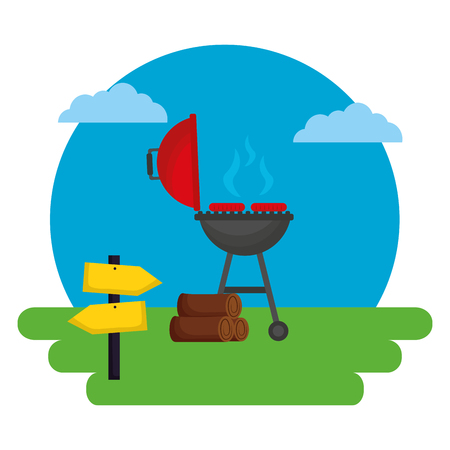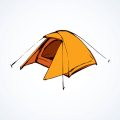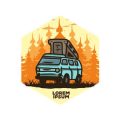Introduction to Holiday Weekend Camping
Camping during a holiday weekend is a classic American tradition. Whether it’s Memorial Day, Fourth of July, Labor Day, or Thanksgiving, these long weekends offer the perfect chance to escape into nature with family and friends. Campsites across the U.S. fill up fast, and outdoor spaces buzz with excitement as people celebrate, relax, and enjoy the great outdoors.
Why Preparation Matters
Proper planning can make or break your camping experience—especially on busy holiday weekends. With campsites often crowded and stores closed or low on supplies, having a well-thought-out packing list is essential. Being prepared not only ensures comfort and safety but also helps you avoid common hassles like forgotten gear or last-minute shopping trips.
Popular U.S. Holiday Weekends for Camping
| Holiday Weekend | Typical Camping Activities | Weather Considerations |
|---|---|---|
| Memorial Day | Grilling, hiking, fishing | Cool nights, possible rain showers |
| Fourth of July | Fireworks, swimming, picnics | Hot days, thunderstorms in some regions |
| Labor Day | Boating, campfire cooking | Warm days, cooler evenings |
| Thanksgiving | Feasting, storytelling around the fire | Chilly weather, early sunsets |
Key Factors to Consider Before Heading Out
- Campsite Reservations: Book early—popular spots fill up months in advance.
- Packing Essentials: Tailor your gear to the season and activities planned.
- Local Regulations: Check fire bans, pet policies, and quiet hours.
- Weather Forecast: Always check before you leave and pack accordingly.
- Crowds: Expect more people than usual; plan for extra time and patience.
- Sustainability: Practice Leave No Trace principles to keep parks beautiful.
With the right preparation and knowledge of what to expect, your holiday weekend camping adventure can be fun, memorable, and stress-free.
2. The All-Season Camping Gear Checklist
When youre heading out for a holiday weekend camping trip, having the right gear can make all the difference—no matter if its the heat of summer or the chill of winter. While each season brings its own challenges, there are some essentials every camper should pack for a comfortable and successful adventure in the great outdoors.
Must-Have Camping Gear for Every Season
| Gear Item | Why You Need It | Seasonal Tip |
|---|---|---|
| Tent with Rainfly | Shelter from weather and bugs | Opt for a 4-season tent for cold or unpredictable climates |
| Sleeping Bag | Warmth at night | Check temperature rating to match expected lows |
| Sleeping Pad or Air Mattress | Cushion and insulation from the ground | Add an extra foam pad in winter for more warmth |
| Headlamp or Flashlight (with extra batteries) | Lighting after dark | Packing both is smart—headlamps are hands-free! |
| Camp Stove or Portable Grill | Cooking meals easily at your site | Bring fuel compatible with colder temps if winter camping |
| Reusable Water Bottles & Water Filter/Purifier | Stay hydrated safely from any water source | Packed ice helps keep water cool in summer, insulated bottles prevent freezing in winter |
| Weather-Appropriate Clothing (layers) | Comfort and protection in changing conditions | Packing layers allows you to adjust as temperatures change day-to-night |
| First Aid Kit | Treat minor injuries or illnesses on the go | Add allergy meds or insect sting relief during spring and summer trips |
| Multi-tool or Camp Knife | Versatile for repairs, cooking, and emergencies | A must-have year-round! |
| Campsite Chairs & Table (optional but recommended) | Adds comfort to your camp setup for meals and relaxing by the fire | Collapsible styles are easiest to pack no matter the season |
| Fire Starter (matches, lighter, fire starter sticks) | Essential for warmth, light, and cooking over a campfire (where permitted) | Drier tinder is important in wet weather; waterproof matches help! |
The Basics: Don’t Leave Home Without These Essentials!
- ID, park pass, and campsite reservation info: Always have these handy when checking into state or national parks.
- Sunscreen & Bug Spray: Year-round protection against UV rays and bugs is crucial—yes, even in winter!
- Trash Bags: Leave no trace! Always pack out what you bring in.
- Pocket-sized map or GPS: Especially useful if cell signal is spotty at your campsite.
Packing Pro Tips for Holiday Weekends:
- Create a checklist ahead of time: Avoid last-minute stress by organizing gear early.
- Packing cubes or bins: These make it easy to grab what you need without digging through your whole car.
- Laminated checklist card: Keep one with your gear so you never forget a must-have item again!
No matter if youre camping under starry summer skies or bundled up around a winter campfire, these essentials will help make your holiday weekend fun, safe, and comfortable!

3. Spring and Summer Essentials
Stay Cool, Safe, and Comfortable When Temperatures Rise
Camping during the spring and summer months is a classic American tradition, especially over holiday weekends like Memorial Day, Fourth of July, or Labor Day. To make the most of your warm-weather adventure, it’s important to pack smart and prepare for sun, bugs, and heat. Here are the must-have items and practical tips for a fun and safe trip.
Warm-Weather Camping Packing List
| Item | Why You Need It |
|---|---|
| Tent with Mesh Panels | Provides ventilation while keeping bugs out |
| Lightweight Sleeping Bag or Sheet | Keeps you comfortable without overheating |
| Portable Fan or Battery-Operated Fan | Helps you stay cool inside your tent |
| Sunscreen (SPF 30+) | Essential for protecting your skin from UV rays |
| Bug Spray with DEET or Picaridin | Keeps mosquitoes and ticks at bay |
| Wide-Brimmed Hat & Sunglasses | Shields your face and eyes from the sun |
| Refillable Water Bottles & Hydration Packs | Avoid dehydration during hot days outdoors |
| Quick-Dry Clothing & Swimsuits | Great for water activities and sweat management |
| Campsite Shade (Pop-Up Canopy or Tarp) | Creates a cool retreat during midday heat |
| Sandals or Water Shoes | Perfect for rivers, lakes, or showers at campgrounds |
| Portable Cooler with Ice Packs | Keeps food and drinks cold all weekend long |
| Citronella Candles or Bug-Repellent Lanterns | Adds extra protection against evening insects |
| Aloe Vera Gel or After-Sun Lotion | Soothes skin after long hours in the sun |
| Pocket Blanket or Picnic Mat | Makes it easy to relax anywhere at campgrounds or parks |
Packing Tips for Spring & Summer Camping Trips:
- Dress in Layers: Mornings and nights can still get chilly, even in summer.
- Avoid Cotton: Choose moisture-wicking fabrics to stay dry and comfortable.
- Pest Control: Set up your tent away from standing water and keep food sealed to avoid attracting bugs.
- Sunscreen Routine: Reapply sunscreen every two hours, especially after swimming or sweating.
- Campsite Location: Look for shaded areas when pitching your tent to help manage daytime temperatures.
Your Spring & Summer Camping Experience Made Easy!
Packing thoughtfully ensures your holiday weekend camping trip is memorable for all the right reasons. Enjoy sunny days, starry nights, and everything in between by staying prepared with these essentials.
4. Fall and Winter Essentials
Camping during fall and winter holiday weekends in the U.S. is all about embracing crisp air, colorful leaves, and even snowy adventures—but cold weather comes with its own set of challenges. Here’s what you’ll need to stay warm, comfortable, and safe while enjoying those shoulder-season escapes.
Must-Have Gear for Chilly Conditions
| Category | Essential Items |
|---|---|
| Sleeping | – Cold-weather sleeping bag (rated for temps below expected lows) – Insulated sleeping pad or cot – Extra blankets or a packable quilt |
| Clothing | – Base layers (moisture-wicking & thermal) – Insulating mid-layers (fleece or down) – Waterproof outerwear – Wool socks, beanie, gloves, scarf – Sturdy waterproof boots |
| Shelter | – 4-season tent or tent with a solid rainfly – Tarp or footprint for ground insulation – Tent heater (propane-powered; use with caution & ventilation) |
| Cooking & Hydration | – Insulated water bottles (prevents freezing) – Hot beverage thermos – Camp stove suitable for cold temps – Extra fuel (cold can reduce efficiency) |
| Safety & Comfort | – Headlamp with extra batteries (days are shorter) – Fire starter kit & dry kindling – First aid kit with hand warmers – Emergency blanket or bivy sack – Traction aids for icy trails/roads (yaktrax, microspikes) |
Packing Tips for Fall and Winter Camping Trips
- Layer Up: Dress in layers you can add or remove as temps change throughout the day.
- Plan for Early Nightfall: Bring extra lighting—sunset comes early!
- Keep Gear Dry: Pack items in dry bags or plastic bins to protect from rain, snow, and condensation.
- Meal Prep: Choose meals that are easy to cook and eat hot—think chili, soups, and oatmeal.
- Stay Powered Up: Cold drains batteries quickly; bring backups for headlamps, lanterns, and phones.
- Mind the Forecast: Always check weather conditions before heading out, especially during unpredictable shoulder seasons.
Pro Tips for Cozy Holiday Weekends Outdoors
- Add a hot water bottle to your sleeping bag before bed—it’s an old-school trick that works wonders.
- Create a campfire gathering spot with camp chairs and plenty of blankets so everyone stays warm while sharing s’mores and stories.
- If youre camping in snow, stomp down an area before pitching your tent to create a flat spot and reduce heat loss.
- Bring a deck of cards or travel games for long evenings inside the tent or camper.
5. Smart Packing Tips and Safety Reminders
Pro Packing Strategies for Holiday Weekends
Holiday weekends mean crowded campgrounds, jam-packed car trunks, and plenty of excitement. To make the most of your trip, smart packing is a must. Here are easy-to-follow strategies to help you maximize space and stay organized:
Packing Hacks for Limited Car Space
| Packing Tip | How It Helps |
|---|---|
| Use Soft-Sided Bags | Duffel bags and backpacks fit better in tight spaces than hard cases. |
| Pack by Category | Group kitchen gear, clothing, and sleeping items together for quick access. |
| Roll Clothes Instead of Folding | Saves space and reduces wrinkles. |
| Nest Items Inside Each Other | Put smaller items (like utensils) inside pots or shoes to save room. |
| Create a Grab-and-Go Bin | Keep essentials like first-aid kits, flashlights, and snacks in one bin near the trunk opening. |
| Label Everything | Use zip-top bags or small containers with labels for easy finding at camp. |
| Leave Non-Essentials at Home | Stick to the packing lists—don’t bring extras “just in case.” |
Safety Reminders for Busy Campgrounds
Crowded holiday weekends call for extra caution. Keep these safety tips top-of-mind:
- Campfire Safety: Only use designated fire rings or pits, never leave fires unattended, and fully extinguish before bed or leaving camp.
- Food Storage: Use bear-proof containers where required, and never store food in your tent.
- Respect Quiet Hours: Many parks enforce quiet hours—check posted rules to avoid fines or complaints from neighbors.
- Be Aware of Wildlife: Don’t feed animals. Store trash securely and clean up all crumbs to keep critters away.
- First Aid Ready: Know where your kit is packed and review basic first aid skills before you go.
- Plan for Crowds: Arrive early for the best campsites and parking spots; expect more foot traffic around trails and shared spaces.
- Know Emergency Contacts: Save the campground’s ranger station number and nearest hospital info on your phone just in case.
- Packing Out Trash: Leave no trace—always pack out what you pack in, including food scraps and wrappers.
Packing Priority Checklist for Holiday Camping Weekends
| Essentials to Pack Last (Easy Access) |
|---|
| – First Aid Kit – Flashlights/Headlamps – Snacks & Water Bottles – Rain Gear – Maps/Park Passes – Phone Charger/Power Bank |


